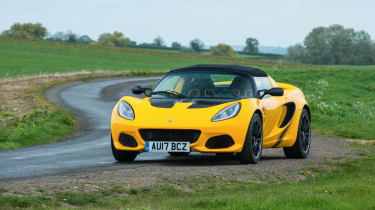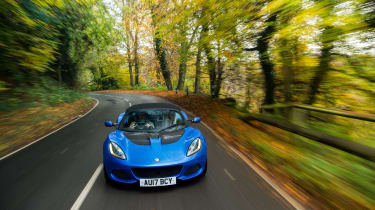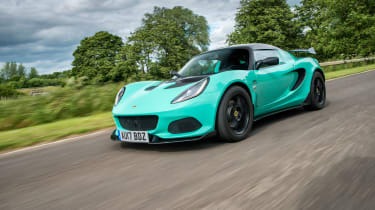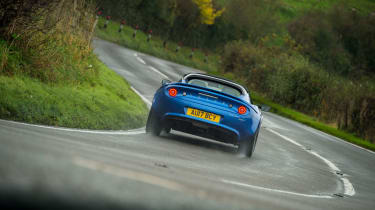Lotus Elise review – is the featherweight sports car as good as ever?
The Elise, with exceptional feel and control as well as compliance and ride quality, couldn’t be anything other than a Lotus
The current Lotus Elise is as beautifully simple, pleasingly compact and bristling with energy and feedback as it was when it was first released 22 years ago. Cynics will argue that it hasn’t changed and developed enough – it’s still built around an extruded and bonded alumium chassis, as it alwas has been. But in reality the Elise highlights just how overweight, over-the-top and cumbersome its so-called rivals have become. The Elise is the perfect antidote to modern cars without feeling in the slightest bit decrepid or outdated.
> Find out what else won in our 2017 Car of the Year awards
Whether you want your Elise to be the consumate B-road sports car or a focussed track car there’s a model for you. The range starts from the road-biased Sport model and gets more intense as you graudate through to Sprint to Cup. The Sport and Sprint models can be bought with either a naturally aspirated 1.6-litre four-cylinder or a supercharged 1.8, with the bigger engine they get a 220 suffix to their name. The Cup 250 and Cup 260 use the same 1.8-litre engine, but the Toyota-sourced engine is stretched to make more power and the cars get motorsport-developed upgrades and serious aerodynamic additions.
More reviews
Group tests
In-depth reviews
Reviews
- Analogue Lotus Elise SuperSport review: the Elise perfected?
- Lotus Elise Cup 250 review
- Lotus Elise review – is the featherweight sports car as good as ever?
- Lotus Elise Sprint 220 review – is this the sweet spot in the Elise range?
- 2016 Lotus Elise Cup 250 review - the fastest Elise ever
- Lotus Elise S Cup review - prices, specs and 0-60 time
- Lotus Elise S Club Racer review, specs and performance
The Sport 220 is the sweet spot of the Elise range, providing the just the right combination of grip and power. The regular Sport’s engine is a little too weak, while the Cup and Race models have more power than you need. As a result, the Sport 220 has been crowned our Sports Car of the Year 2017.
Lotus Elise in detail
Performance and 0-60 time – The acceleration times of the Elise range vary from 6sec down to 3.8sec.
Engine and gearbox – Modern four-cylinder engines are rarely as enjoyable and as sonorous as the two found in the middle of the Elise
Ride and handling – This is where the Elise shines. It can show more expensive cars what handling really is, while its ride would show up many luxury cars
MPG and running costs – Lotus’s lightweight attitude hasn’t just helped the Elise become a great drivers’ car, it’s also helped it be surprisingly economical
Interior and tech – Not much to talk about here. It’s bare and completely lacking in technology, and it’s all the better for it
Design – It might not be radically different from the original, 22-year-old Elise, but that’s no bad thing
Prices, specs and rivals
The cheapest Elise, the Sport, is available from £32,300; not too bad for a mid-engined, lightweight sports car. That dedication to a low kerb weight, 856kg to be exact, does mean you don’t get many luxuries for your money; full carpets, floor mats, air-conditioning, a Bluetooth-enabled stereo, cruise control and even sound insulation are all optional extras.
> Read our review of the Porsche 718 Boxster
The Sprint is another £4700 more than the Sport, but don’t expect a lavish array of equipment for the extra outlay, the money goes on exotic materials to make the Elise 26kg lighter. The engine cover, roll-hoop cover and vented bonnet panel are made entirely from carbonfibre, the rear screen is polycarbonate, the wheels are made from a forged alloy rather than cast and the Sprint is fitted with a lithium-ion battery.
The Sport 220 and Sprint 220 cost £39,300 and £44,600, respectively. Both models are almost identical to the cheaper versions, except in the place of the atmospheric 1.6 is a 1.8-litre Supercharged Toyota engine. The bigger motor bumps the weight of the Elise up by 50kg, but that’s offset by an extra 83bhp.
The Elise Cup models are very serious cars with very serious price tags; the Cup 250 costs £47,800 while the 260 is around £60k. The 1.8-litre supercharged engine is tuned to produce more power, 243bhp in the Cup 250 and 250bhp in the Cup 260. Both cars have improved stiffness with a T45 steel roll over bar and better aerodynamics – the 260 produces 180kg of downforce at 151mph thanks to its large rear wing and vented front arches. The Cup 260 also gets two-piece brake discs and two-way adjustable Nitron dampers.
Porsche’s four-cylinder 718 Boxster starts at £44,758 making it comparable, on price, to the Sport 220. The Porsche might well be a better equipped car, easier to live with and faster on paper, but it doesn’t provide the same involvement or excitement as the Lotus. Plus, the supercharged engine in the Elise sounds far nicer than the thrummy flat-four in the 718.
The Abarth 124 Spider is fractionally cheaper than the even the most basic Elise at £29,620. It’s not as sharp as the Lotus, by a significant margin, but it’s a charming, fun and loveable convertible.
The only car that will really get close to the Cup 260’s sense of commitment and dedication to driving thrills for anywhere near the same sort of money is a Lotus Exige, but it is just under £10,000 more than the Cup 250.







